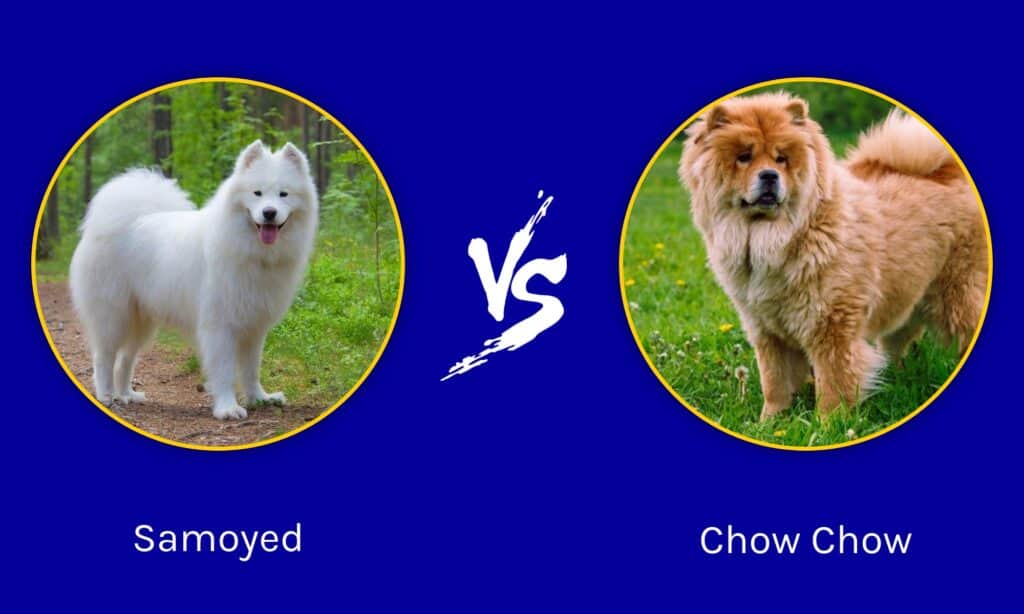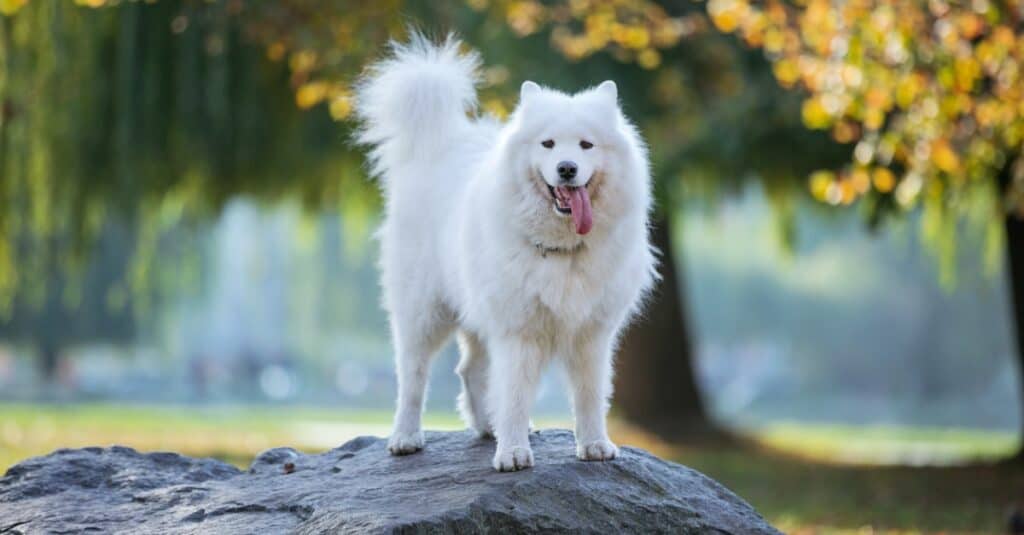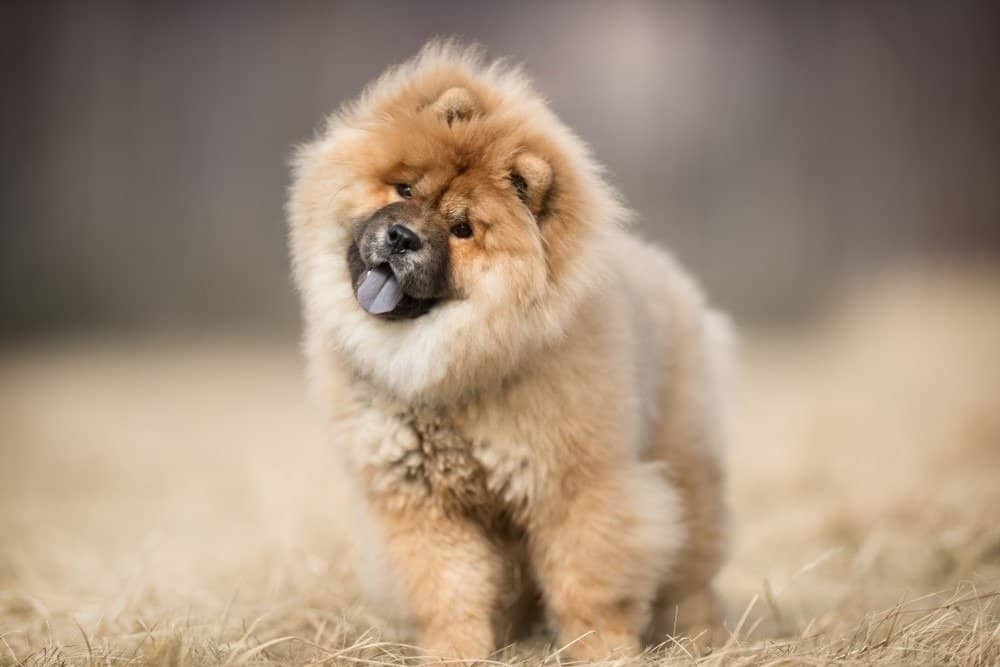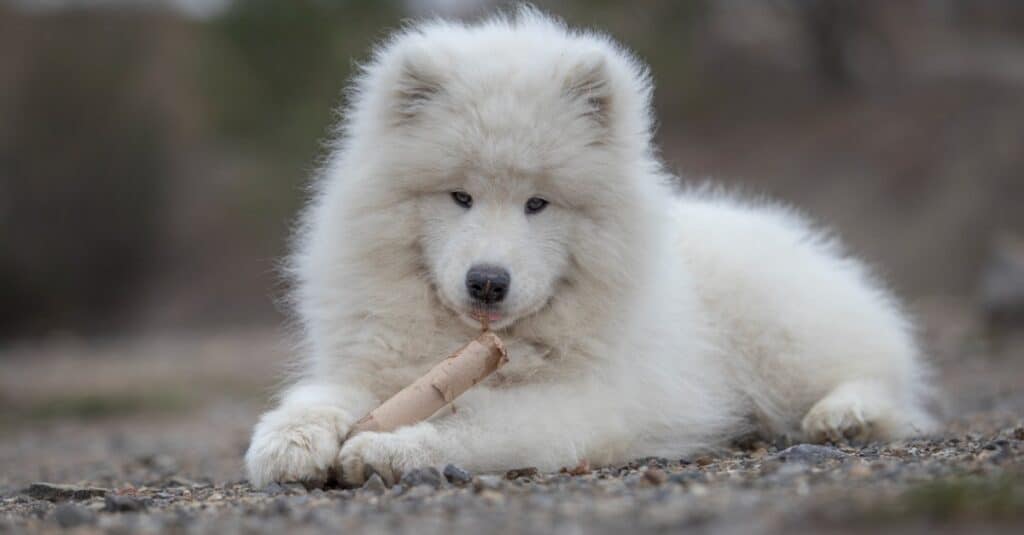Samoyeds and Chow Chows are both fluffy, medium-sized dogs—but they also have many distinguishing features. Their appearances vary, including their size, fur texture, and color. Chow Chows tend to live shorter and less healthy lives than Samoyeds.
Let’s explore more about these breeds and learn more about what sets them apart!
Comparing Samoyed vs Chow Chow

| Samoyed | Chow Chow | |
|---|---|---|
| Size | 19-23.5 inches, 35-65 pounds | 17-20 inches, 45-70 pounds |
| Appearance | Average snout, long double coat in white, cream, biscuit, or white and biscuit | Short, wrinkly snout, medium-length double coat in black, cinnamon, blue, cream, or red |
| Lifespan | 12-14 years | 9-15 years |
| Temperament | Extremely affectionate, friendly, alert | Very affectionate, reserved, protective |
| Energy Level | Extremely High | Moderate |
| Trainability | Easy | Intermediate |
| Drooling Level | Low | Moderate |
| Barking Level | High | Low |
| Health | Healthy overall but prone to hip dysplasia, eye, and cardiac diseases | Struggles to breathe due to brachycephalic snout, prone to skin conditions |
Key Differences Between the Samoyed and Chow Chow
The key differences between the Samoyed and Chow Chow are appearance, lifespan, temperament, energy levels, trainability, barking levels, and health.
Let’s discuss all of these more in-depth below!
Samoyed vs Chow Chow: Size

Chow Chows have an average weight of 45-70 pounds.
©iStock.com/Andrey Danilov
Samoyeds are larger in height, standing 19-23.5 inches compared to Chow Chows at 17-20 inches. However, Chows may weigh slightly more, with an average weight of 45-70 pounds. Samoyeds typically weigh 35-65 pounds. This accounts for the slightly stockier appearance of a Chow Chow compared to the longer-legged Samoyed.
Samoyed vs Chow Chow: Appearance
Samoyeds have a mesaticephalic, or average-length, snout. They always have long, light-colored fur that can be white, cream, biscuit, or white and biscuit.
A Chow Chow’s short snout is known as brachycephalic, and it causes major health problems that we’ll dive into below. The short snout also makes it look wrinkly on the face. Another unique feature is its blue tongue, which develops around the time a puppy’s eyes open.
Chow Chows have two coat types: rough and smooth. Rough Chows have medium-length fur that grows longer on their necks and thighs, while smooth Chow Chows have shorter fur. Their fur may be black, blue, cinnamon, cream, or red in color.
Samoyed vs Chow Chow: Lifespan

Samoyeds live 12-14 years on average.
©iStock.com/photobac
Samoyeds have longer lifespans on average, living 12-14 years compared to Chow Chows at 9-15 years.
Samoyed vs Chow Chow: Temperament
Chow Chows are very affectionate with family but may lack patience with children and other dogs. Around strangers, they may be stand-offish or display guarding tendencies. They tend to be much more reserved than Samoyeds, however, who think everyone is a friend! This includes children and strangers. However, Samoyeds might be stand-offish with other pups or even dog-selective.
Around family, Samoyeds will be incredibly loving and even clingy. They were bred as close companions and shouldn’t be left alone for long periods. They want to be where you are!
Samoyed vs Chow Chow: Energy Level
Samoyeds have very high energy levels and need a lot of physical and mental stimulation to stay healthy. This will also help to prevent problem behaviors, which often stem from boredom.
Chow Chows have moderate energy levels and will struggle to exercise in hot conditions. Sadly, their shortened snout causes breathing difficulties and makes them more susceptible to heatstroke. For this reason, you must keep an eye on your pup during exercise and when it’s hot in the summer. Some days, it’ll be best to exercise them indoors in an air-conditioned room rather than venturing outside in the heat.
Samoyed vs Chow Chow: Trainability

Chow chows might be difficult to train without dog training experience.
©BIGANDT.COM/Shutterstock.com
Chow Chows are well-known for their independent, stubborn streak! These pups will be difficult to train if you don’t have dog training experience. With patience, consistency, and high-value rewards, you’ll see progress.
Samoyeds are easy to train because they love to please people. They’re also very intelligent!
Samoyed vs Chow Chow: Drooling Level
Samoyeds rarely drool, but Chow Chows might leave little puddles when they get excited about food or after drinking water. They aren’t excessive droolers, but you’ll still be picking up some mess!
Samoyed vs Chow Chow: Barking Level
Samoyeds are very chatty dogs. Their barking tendencies can become problematic if they develop separation anxiety, are poorly trained, or don’t receive enough physical or mental stimulation throughout the day. It’s important to ensure their needs are met if you notice problem behaviors like this.
Chow Chows, on the other hand, will only bark to alert you. This aligns perfectly with their guarding tendencies.
Samoyed vs Chow Chow: Health

Samoyeds are prone to hip dysplasia, eye conditions, and heart disease.
©iStock.com/Roman Bjuty
Samoyeds typically have good health but are prone to many difficulties, including hip dysplasia, eye conditions, and heart disease. Many conditions can be tested for by a reputable breeder.
Unfortunately, there are no reputable breeders who breed Chow Chows. Poor breeding is what causes their short snouts, which are unfortunately accepted and even required by breed standards in the United States.
Short, or brachycephalic, snouts lead to several health problems. The most notable are difficulty in breathing and exercise intolerance.
Even a Chow without other health problems will struggle to breathe on a daily—this is unfair to the dog, and we never recommend purchasing a Chow Chow puppy from a breeder. If you’d like one, we highly recommend rescue!
The photo featured at the top of this post is © iStock.com/photobac
Ready to discover the top 10 cutest dog breeds in the entire world?
How about the fastest dogs, the largest dogs and those that are -- quite frankly -- just the kindest dogs on the planet? Each day, AZ Animals sends out lists just like this to our thousands of email subscribers. And the best part? It's FREE. Join today by entering your email below.
Thank you for reading! Have some feedback for us? Contact the AZ Animals editorial team.






